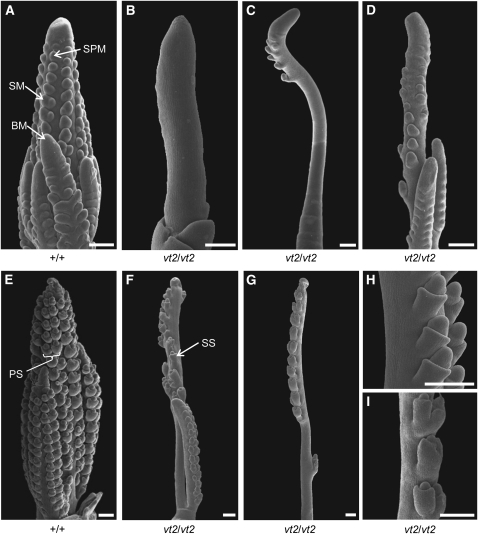Figure 4.
Scanning Electron Micrographs of Developing Inflorescences.
(A) Wild-type field-grown tassel at 3-mm stage exhibiting BMs at the base and SPMs covering the branches and main spike.
(B) vt2 field-grown tassel at 3-mm stage exhibiting complete lack of BM and SPM initiation.
(C) vt2 field-grown tassel at 4- to 5-mm stage producing a few SPMs near the tip.
(D) vt2 greenhouse-grown tassel at 4- to 5-mm stage displaying a weak mutant phenotype, with several BMs at the base and many SPM on the branches and main spike.
(E) Wild-type greenhouse-grown tassel later in development at 6- to 7-mm stage exhibiting production of paired SMs in regular rows on all branches and the main spike.
(F) vt2 greenhouse-grown tassel later in development at 6- to 7-mm stage showing production of paired SMs on the branches and paired or single SMs on the main spike.
(G) vt2 mutant tassel at 6- to 7-mm stage grown at cooler greenhouse temperatures compared with typical greenhouse conditions for maize. Mutants grown in these conditions display intermediate phenotypes between field-grown and typical greenhouse-grown tassels, with no BMs and few SPMs, which give rise to paired or single SM.
(H) Close-up of 4- to 5-mm vt2 tassel grown at cooler greenhouse temperatures, displaying two files of single SMs produced along the main spike.
(I) Close-up of 6- to 7-mm vt2 tassel (from [G]) grown at cooler greenhouse temperatures, displaying both paired and single SMs along the main spike.
PS, paired spikelet; SS, single spikelet. Bars = 250 μm.

